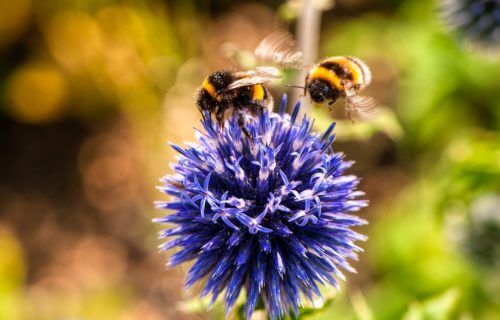LONDON — Play time is an essential part of any human childhood. Now, new research has documented object play behavior by an insect for the first time ever. Scientists at Queen Mary University of London report that over the course of various experiments and setups, bumblebees “went out of their way” to roll a wooden ball repeatedly despite there being no practical reason or incentive to do so. In other words, the bees were playing!
Just like human adults and adolescents, researchers add that younger bumblebees tended to play with the wooden balls more frequently. Male bees also spent more time rolling the balls than their female counterparts. All in all, study authors say these findings add considerable weight to the increasingly popular opinion among scientists that bumblebees may experience positive feelings.
Researchers tracked 45 bumblebees in an arena and gave the insects a choice when it came time to either travel through an unobstructed path to reach a feeding area or deviate from the path to get closer to the wooden balls.
Individual bees ended up rolling balls between one and 117 times over the course of the experiment. Study authors explain this type of repeated behavior suggests the ball-rolling was rewarding, or perhaps even fun, on some level for the bees.
Bees remember how fun it is to play
The team says a second experiment including another 42 bees supports this theory even further. This time around, the insects had access to two colored chambers, one that always contained movable balls and one holding no objects at all. Then, scientists removed the balls entirely, and the bees had a choice between the two chambers. Even though the balls were not there, bees still showed a preference for the color of the chamber they previously associated with the wooden balls.
This experimental setup, study authors explain, eliminated any theory that the bees were moving the balls for any greater purpose other than play. Rolling the balls didn’t serve any survival purpose, like gaining food, clearing clutter, or mating, and the team notes that the bees played under stress-free conditions.
These findings are a continuation of earlier work by the same lab at Queen Mary. Researchers previously found bumblebees are capable of learning to score a goal, by rolling a ball to a target, in exchange for a sugar reward. That earlier study also observed bumblebees rolling balls outside of the experiment, without the involvement of any rewards or food.
Now, researchers have recorded bumblebees rolling balls repeatedly without being trained and without receiving any food in exchange. In conclusion, study authors believe these behaviors were both voluntary and spontaneous, and therefore comparable to play behaviors seen in other animals.
“It is certainly mind-blowing, at times amusing, to watch bumble bees show something like play. They approach and manipulate these ‘toys’ again and again. It goes to show, once more, that despite their little size and tiny brains, they are more than small robotic beings. They may actually experience some kind of positive emotional states, even if rudimentary, like other larger fluffy, or not so fluffy, animals do. This sort of finding has implications to our understanding of sentience and welfare of insects and will, hopefully, encourage us to respect and protect life on Earth ever more,” says first study author Samadi Galpayage, PhD student at Queen Mary University of London, in a university release.
“This research provides a strong indication that insect minds are far more sophisticated than we might imagine. There are lots of animals who play just for the purposes of enjoyment, but most examples come from young mammals and birds,” explains Professor Lars Chittka, Professor of Sensory and Behavioural Ecology at Queen Mary University of London, head of the lab and author of the recent book “The Mind of a Bee.”
“We are producing ever-increasing amounts of evidence backing up the need to do all we can to protect insects that are a million miles from the mindless, unfeeling creatures they are traditionally believed to be.”
The study is published in the journal Animal Behavior.

